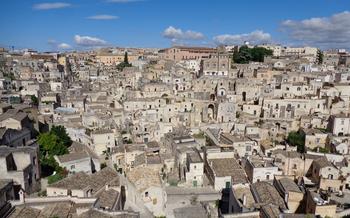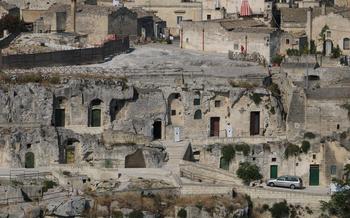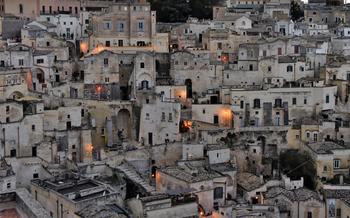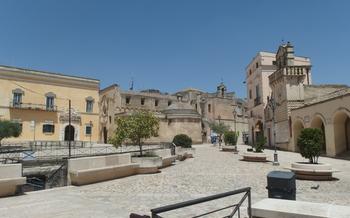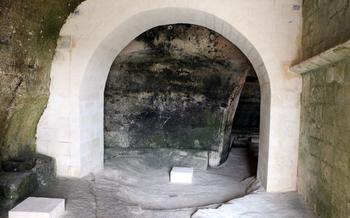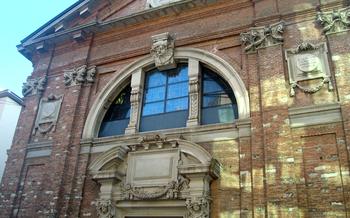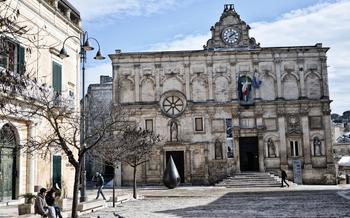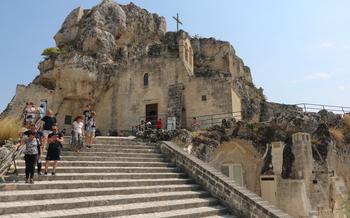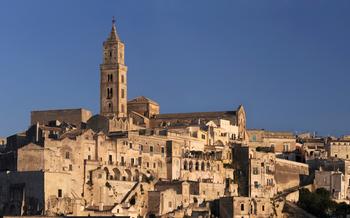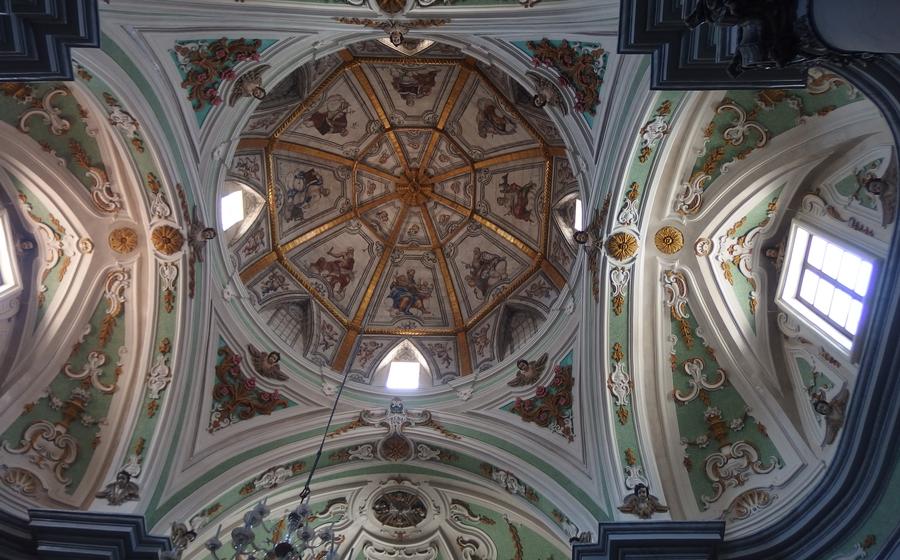
Chiesa del Purgatorio
- Introduction
- History of the Chiesa del Purgatorio
- Location
- Architectural Features
- Visiting the Church
- The Frescoes
- The Ossuary
- The Confraternity of Purgatory
- Significance of the Church
- The Crypt
- Local Traditions and Events
- Nearby Attractions
- Suggested Itineraries
- Accommodation and Dining
- Insider Tip
Introduction
Matera, a captivating city nestled in southern Italy's Basilicata region, boasts a rich and intricate history that spans millennia. Once home to ancient civilizations, it later became a thriving Byzantine and Norman settlement. In the 16th century, Matera fell under Spanish rule, leaving behind a legacy of architectural and cultural influences that can still be seen today. The city's unique urban fabric, characterized by cave dwellings carved into the limestone cliffs, earned it the title of European Capital of Culture in 201Matera's enchanting atmosphere, coupled with its historical significance, makes it a must-visit destination for travelers seeking an authentic Italian experience.
When planning a trip to Matera, visitors can expect to be captivated by its labyrinthine streets, stunning panoramic views, and an abundance of cultural treasures. From exploring the Sassi, Matera's ancient cave dwellings, to marveling at the intricate rupestrian churches, there's no shortage of things to see and do. The city's vibrant culinary scene, with its focus on locally sourced ingredients and traditional dishes, is sure to delight food enthusiasts. Matera's strategic location also makes it an ideal base for exploring other captivating destinations in Puglia, such as the Trulli houses of Alberobello, the baroque city of Lecce, and the pristine beaches of Salento.
History of the Chiesa del Purgatorio
The construction of the Chiesa del Purgatorio began in 1743 under the direction of the Confraternity of Purgatory, a religious organization dedicated to praying for the souls of the deceased. The church was built on the site of an ancient cave dwelling, which was believed to be the entrance to Purgatory, a place where souls atone for their sins before entering Heaven.
The Confraternity of Purgatory played a significant role in the construction and maintenance of the church. They organized fundraising events, collected donations, and oversaw the artistic commissions for the interior decoration. The church became a symbol of faith and devotion for the people of Matera, who believed that praying in the church would help their loved ones in Purgatory.
Legends and stories abound about the Chiesa del Purgatorio. It is said that the church was built on a spot where a shepherd witnessed a vision of souls suffering in Purgatory. Another legend tells of a pious woman who was miraculously cured of a terminal illness after praying in the church. These stories have added to the mystique and aura of the Chiesa del Purgatorio, making it a popular destination for pilgrims and tourists alike.
Location
The Chiesa del Purgatorio is situated in the heart of Matera's ancient Sassi district, a UNESCO World Heritage site renowned for its unique cave dwellings and intricate network of narrow streets. The church's exact address is Via Purgatorio, 21, and it is conveniently located within walking distance from other major attractions in the city center.
To reach the church, visitors can either stroll through the picturesque alleys of the Sassi or take advantage of the convenient public transportation system. The nearest bus stop, "Via Lucana," is just a short walk away, connecting visitors to various parts of the city.
When approaching the church, visitors are greeted by a captivating façade that hints at the artistic treasures within. The church stands as a testament to the enduring faith and devotion of the Materan people, serving as a symbol of hope and redemption for generations.
Architectural Features
The Chiesa del Purgatorio stands out for its unique architectural features that blend Romanesque and Baroque styles. Its façade, characterized by a simple and austere design, features a rose window and a Gothic portal that hints at the artistic influences from the North. The church's bell tower, rising high above the city, adds a touch of grandeur to the overall structure.
The interior of the church is equally captivating, showcasing a harmonious blend of styles. The nave, with its barrel vaulted ceiling, is supported by massive columns adorned with intricate carvings. The side chapels, dedicated to various saints, are embellished with frescoes, sculptures, and ornate altars.
One of the most striking features of the church is its intricate rose window. This magnificent stained-glass masterpiece depicts scenes from the life of Christ and the Virgin Mary, casting a warm and colorful glow into the interior. The window's intricate details and the vibrant hues of the glass create a sense of awe and wonder.
Another highlight of the Chiesa del Purgatorio is its ossuary, a macabre yet fascinating underground chamber. The ossuary, a stark reminder of the transience of life, houses hundreds of human skulls and bones arranged in artistic patterns. This unique feature adds to the church's allure, making it a place of both beauty and contemplation.
Visiting the Church
The Chiesa del Purgatorio is open to the public daily, with varying hours of operation depending on the season. Admission fees are typically charged, but there may be discounts or free entrance for children or seniors. Guided tours are available in several languages, offering a deeper insight into the history, art, and religious significance of the church. Visitors can also choose to explore the church independently, taking their time to admire the frescoes, sculptures, and architectural details.
When visiting the church, it is important to dress respectfully, as it is a place of worship. Photography and filming are allowed, but visitors should be discreet and avoid disturbing other visitors or religious services. The church also has a small gift shop where visitors can purchase souvenirs, books, and postcards related to the church and its history.
The Frescoes
The Chiesa del Purgatorio is renowned for its stunning frescoes, which adorn the walls and ceilings of the church. These vibrant and intricate paintings were created by local artists in the 17th and 18th centuries, using techniques that have been passed down through generations.
The frescoes depict biblical scenes and narratives, illustrating stories from the Old and New Testaments. They showcase the lives of saints, the suffering of Christ, and the torments of purgatory. The artists used their skills to capture the emotions and expressions of the figures, creating a powerful and moving visual experience for visitors.
The frescoes are not only beautiful works of art but also hold deep symbolic and allegorical meanings. They serve as a reminder of the transience of life, the importance of redemption, and the hope of salvation. Visitors can spend hours admiring the intricate details and discovering the hidden messages embedded within these remarkable paintings.
The Ossuary
The Chiesa del Purgatorio also houses an ossuary, which was discovered during restoration work in 197The ossuary is a small underground chamber lined with shelves filled with the bones and skulls of over 1,000 people. The remains date back to the 18th and 19th centuries and were originally exhumed from the church's cemetery.
The ossuary has become a controversial site, as some visitors find it macabre and disrespectful to the dead. However, it is also a reminder of the mortality and the importance of commemorating our deceased loved ones. The ossuary offers a unique glimpse into the burial practices and traditions of the past, and it is a powerful testament to the power of faith and devotion.
The Confraternity of Purgatory
The Chiesa del Purgatorio is inextricably linked to the Confraternity of Purgatory, a religious brotherhood that played a crucial role in the church's construction and maintenance. Founded in the 16th century, the confraternity consisted of devout laypeople dedicated to praying for the souls trapped in purgatory, a state of purification before entering heaven.
Throughout history, the confraternity organized processions, masses, and other religious ceremonies to honor the dead and seek their salvation. They also provided assistance to the poor and needy, embodying the principles of charity and compassion. The confraternity's unwavering commitment to their mission and the spiritual well-being of the community earned them widespread respect and support.
Today, the Confraternity of Purgatory continues to uphold its traditions and rituals, preserving the legacy of the Chiesa del Purgatorio. Members of the brotherhood still participate in religious processions and services, ensuring that the church remains a vibrant center of faith and devotion for Matera's residents and visitors alike.
Significance of the Church
The Chiesa del Purgatorio holds profound significance for the city of Matera, its people, and the Catholic faith. As a religious sanctuary, it represents a testament to the deeply rooted spirituality and devotion of the Materan community. The church serves as a place of worship, reflection, and remembrance, embodying the belief in the afterlife and the redemption of souls through divine mercy.
Historically, the church has played a pivotal role in shaping the religious and cultural identity of Matera. Its construction and the establishment of the confraternity of Purgatory marked a significant period of spiritual renewal and fervor within the city. The church's enduring presence has reinforced Matera's reputation as a center of religious devotion and pilgrimage.
Artistically and historically, the Chiesa del Purgatorio is a masterpiece of Baroque architecture and religious art. Its unique frescoes, depicting scenes from the Bible and narratives of the afterlife, have garnered widespread recognition and admiration. The church's interior is a testament to the skill and artistry of the local craftsmen and painters who contributed to its creation.
In 1993, the Chiesa del Purgatorio was officially recognized as a UNESCO World Heritage Site, along with the entire historical center of Matera. This prestigious designation acknowledges the church's exceptional universal value as a cultural and historical monument. The inclusion of the church on the UNESCO World Heritage List has further elevated its status and significance, attracting visitors from around the world who seek to witness its beauty and historical importance.
The Crypt
The Chiesa del Purgatorio also houses a small but intriguing crypt, accessible from a narrow staircase located in the left side of the church. The crypt dates back to the 18th century and served as a burial ground for the members of the Confraternity of Purgatory. It is a dimly lit, atmospheric space with low ceilings and rough-hewn walls.
The crypt contains several frescoes depicting scenes from the Bible and the afterlife, including the Last Judgment and the torments of hell. The most striking fresco, however, is the "Dance of Death," which shows a group of skeletons dancing with figures representing different walks of life, from popes and kings to peasants and beggars. This macabre scene is a reminder of the inevitability of death and the need for repentance and salvation.
The crypt is a fascinating glimpse into the beliefs and practices of the Confraternity of Purgatory. It is a place of both beauty and horror, and it serves as a reminder of the power of faith and the enduring fascination with the afterlife.
Local Traditions and Events
The Chiesa del Purgatorio is deeply intertwined with the local traditions and events of Matera. The most significant celebration is the annual Procession of the Madonna della Bruna, held on July This grand religious festival features a procession of the statue of the Madonna della Bruna through the streets of Matera, accompanied by music, dancing, and fireworks.
During Holy Week, the church hosts special religious services and processions, including the evocative "Procession of the Mysteries," which reenacts the Passion of Christ. These events are deeply rooted in Matera's cultural heritage and draw thousands of visitors each year.
Beyond these major events, the church is a gathering place for the local community. Throughout the year, various religious ceremonies, concerts, and exhibitions take place within its walls, further enriching the spiritual and cultural life of Matera.
Nearby Attractions
In the vicinity of the Chiesa del Purgatorio, there's a treasure trove of other captivating attractions that will enrich your exploration of Matera. Just a stone's throw away, the Cathedral of Matera, with its awe-inspiring Romanesque-Apulian architecture, stands as a testament to the city's rich history. Wander through its grand interior, marveling at the intricate frescoes and the sacred atmosphere that permeates the air.
For a journey into Matera's ancient past, delve into the Sassi, the labyrinthine cave dwellings that have earned the city its UNESCO World Heritage status. Explore these atmospheric neighborhoods, where history is etched into every corner, and discover the hidden churches, artisan workshops, and charming cafes that bring the Sassi to life.
Art enthusiasts will find solace in the Museo Nazionale d'Arte Medievale e Moderna della Basilicata, which houses a diverse collection of medieval and modern art from the region. Immerse yourself in the works of local masters, including sculptures, paintings, and intricate religious artifacts that narrate the artistic heritage of Matera and Basilicata.
Beyond these must-see attractions, Matera offers a plethora of other hidden gems waiting to be uncovered. Discover the Palazzo Lanfranchi, a splendid example of Renaissance architecture, or visit the Museo della Scultura Contemporanea, showcasing innovative contemporary artworks in a captivating setting.
As the sun begins to set, take a leisurely stroll along the Via del Corso, Matera's main shopping street, and soak in the vibrant atmosphere as locals and tourists alike gather to socialize, shop, and savor the delectable cuisine that the city is renowned for.
From historical landmarks to artistic treasures and lively piazzas, the area surrounding the Chiesa del Purgatorio offers a captivating blend of attractions that will leave you spellbound.
Suggested Itineraries
One-day itinerary for Matera, including the church: - Start your day with a visit to the Chiesa del Purgatorio, exploring the frescoes and the ossuary. - Climb up to the Sassi di Matera, the ancient cave dwellings that are a UNESCO World Heritage Site, and admire the stunning views of the city. - Visit the Casa Grotta di Vico Solitario, a former cave dwelling that has been transformed into a museum, to learn about the history and culture of Matera. - End your day with a traditional dinner at one of the many restaurants in the Sassi, savoring local specialties like orecchiette con cime di rapa and baccalà alla materana.
Two-day itinerary for Matera, exploring the city in depth: - On day one, follow the one-day itinerary above. - On day two, visit the Museo Nazionale d'Arte Medievale e Moderna della Basilicata, which houses a collection of medieval and modern art from the region. - Take a guided tour of the Sassi di Matera to learn more about their history and architecture. - In the evening, attend a performance at the Teatro Comunale Guerrieri, Matera's main theater.
Multi-day itinerary for Puglia, including Matera as a stop: - Spend two days in Matera, following the two-day itinerary above. - From Matera, take a day trip to the nearby town of Alberobello, famous for its unique trulli houses. - Continue your journey to the seaside town of Polignano a Mare, known for its beautiful beaches and cliffs. - Explore other charming towns and villages in Puglia, such as Ostuni, Locorotondo, and Lecce, each with its own unique character and attractions.
Accommodation and Dining
Matera offers a range of accommodation options for visitors, from budget-friendly guesthouses to luxurious hotels. To immerse yourself in the city's unique atmosphere, consider staying in a traditional sasso dwelling, a charming cave-like structure that provides a truly authentic experience.
For a memorable dining experience, Matera's culinary scene will not disappoint. Savor the flavors of traditional Lucanian cuisine, known for its fresh local ingredients and hearty dishes. Don't miss the chance to try orecchiette con cime di rapa, a local pasta dish with turnip greens, or the flavorful lamb chops.
When it comes to food, Matera is a paradise for those who love to indulge. Try the iconic pane di Matera, a traditional bread with a unique crust, or the delicious salsiccia Lucana, a spicy local sausage. For a sweet treat, the pasticciotti, filled with custard or ricotta cheese, are a must-try.
To enhance your culinary journey, consider joining a cooking class and learning how to prepare some of these local dishes yourself. It's a fantastic way to immerse yourself in Matera's rich culinary traditions.
Insider Tip
Matera's enchanting aura extends beyond the confines of its iconic landmarks. Delve deeper into its hidden gems and embark on an off-the-beaten-path adventure. Discover the secret spot nestled amidst the ancient Sassi, where locals gather for authentic culinary delights. Join a traditional "Sagra" (food festival) and immerse yourself in the vibrant flavors of the region. For a unique perspective, embark on a guided night tour and witness the magical transformation of the city under the starry sky. Matera offers a tapestry of hidden treasures waiting to be unveiled by curious travelers willing to explore beyond the usual tourist routes.
